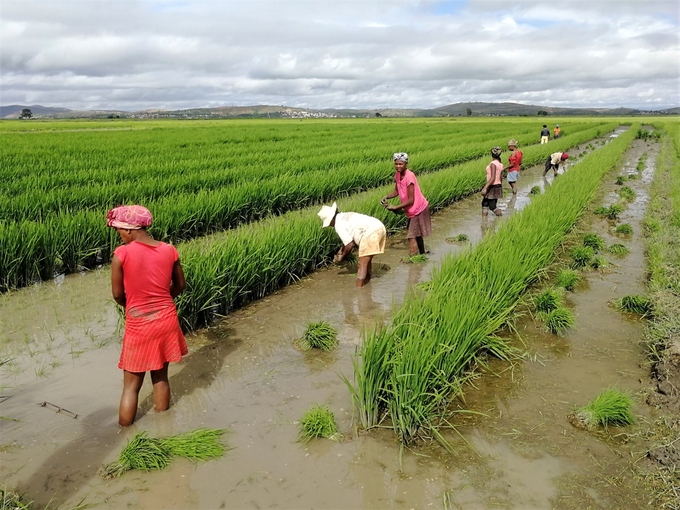May 29, 2025 | 15:59 GMT +7
May 29, 2025 | 15:59 GMT +7
Hotline: 0913.378.918
May 29, 2025 | 15:59 GMT +7
Hotline: 0913.378.918

Growing rice in Madagascar. Photo: FAO/Fanilo Randriatsizafy
The benchmark for world food commodity prices was broadly stable in October, with rising cereal prices more than offset by declines in quotations for other staples, the Food and Agriculture Organization of the United Nations (FAO) reported Friday.
The FAO Food Price Index, which tracks monthly changes in the international prices of a basket of commonly traded food commodities, averaged 135.9 points during the month of October, negligibly below its level in September. With the latest update, the index stood 14.9 percent down from its all-time high recorded in March 2022, while it remained 2.0 percent above its level in October 2021.
The FAO Cereal Price Index increased 3.0 percent during the month. World wheat prices rose by 3.2 percent, mostly reflecting uncertainties related to the Black Sea Grain Initiative and also a downward revision for supplies in the United States of America. International prices of coarse grains increased by 3.5 percent from September, with maize prices rising even more due to lower production prospects in the United States of America and the European Union, along with dry planting conditions in Argentina and uncertainty about exports from Ukraine. International rice prices increased by 1.0 percent.
The FAO Vegetable Oil Price Index declined by 1.6 percent in October and stood nearly 20 percent below its year-earlier level. Rising international quotations for sunflower seed oil were more than offset by lower world prices of palm, soy and rapeseed oils.
The FAO Dairy Price Index dropped by 1.7 percent, with the prices of all dairy products covered down since September. Lower than anticipated purchases by China, lacklustre import demand and the weakening of the Euro against the United States dollar underpinned the drop in October.
The FAO Meat Price Index was down 1.4 percent in October compared to September, with international ovine, pig, bovine and poultry meat prices all declining on broadly subdued global import demand and increasing exportable supplies.
The FAO Sugar Price Index declined 0.6 percent, bolstered by improved production prospects in India. Factors such as rains hampering harvest progress in Brazil, strong import demand from Indonesia and China, and higher ethanol price quotations in Brazil, limited the month-on-month price decline for sugar.
More details are available here. To access benchmark export quotations of various foodstuffs and national retail/wholesale prices of foods please visit FAO’s Food Price Monitoring and Analysis (FPMA) Tool
Lowered forecasts for cereals
In an updated Cereal Supply and Demand Brief also released Friday, FAO lowered its forecast for world cereal production in 2022 to 2 764 million tonnes, a 1.8 percent decline from 2021.
While global wheat production is now forecast at 783.8 million tonnes in 2022, an all-time high, worldwide coarse grains output is expected to drop 2.8 percent to 1 467 million tonnes. World rice production is forecast at 512.6 million tonnes, down 2.4 percent from the 2021 all-time high, but still an overall average crop.
World cereal utilization in 2022/2023 is now forecast to decline to 2 778 million tonnes, 0.7 percent below the 2021/22 level. Likewise, world cereal stocks at the end of seasons in 2023 are forecast to contract by 2.0 percent from their opening levels, down to 841 million tonnes.
Based on those forecasts, the world cereal stocks-to-use ratio is foreseen to decline to 29.4 percent in 2022/23 from 30.9 percent in the previous year.
World trade in cereals in 2022/23 is predicted to register a 2.2-percent contraction to 469 million tonnes.
More details are available here.
For more analysis of recent developments in agricultural markets see the November 2022 issue of Food Outlook, planned to be published on 10 November.
(FAO.org)

(VAN) Vikas Rambal has quietly built a $5 billion business empire in manufacturing, property and solar, and catapulted onto the Rich List.

(VAN) Available cropland now at less than five percent, according to latest geospatial assessment from FAO and UNOSAT.

(VAN) Alt Carbon has raised $12 million in a seed round as it plans to scale its carbon dioxide removal work in the South Asian nation.

(VAN) Attempts to bring down the price of the Japanese staple have had little effect amid a cost-of-living crisis.

(VAN) Fourth most important food crop in peril as Latin America and Caribbean suffer from slow-onset climate disaster.

(VAN) Shifting market dynamics and the noise around new legislation has propelled Trouw Nutrition’s research around early life nutrition in poultry. Today, it continues to be a key area of research.

(VAN) India is concerned about its food security and the livelihoods of its farmers if more US food imports are allowed.